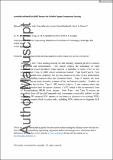| dc.contributor.author | Robinson, Maxwell T. | |
| dc.contributor.author | Tung, Julie | |
| dc.contributor.author | Heydari Gharahcheshmeh, Meysam | |
| dc.contributor.author | Gleason, Karen K. | |
| dc.date.accessioned | 2022-02-11T12:49:42Z | |
| dc.date.available | 2022-02-11T12:49:42Z | |
| dc.date.issued | 2021-03-31 | |
| dc.identifier.issn | 1616-301X | |
| dc.identifier.issn | 1616-3028 | |
| dc.identifier.uri | https://hdl.handle.net/1721.1/140281 | |
| dc.description.abstract | A new volatile organic compounds (VOCs) sensing concept called humidity-initiated gas (HIG) sensors is described and demonstrated. HIG sensors employ the impedance of water assembled at sensor interfaces when exposed to humidity to sense VOCs at low concentrations. Here, two HIG sensor variants are studied—Type I and Type II. Type I sensors benefit from simplicity, but are less attractive in terms of key performance metrics, including response time and detection limits. Type II sensors are more complex, but are more attractive in terms of key performance metrics. Notably, it is observed that the best-in-class Type II HIG sensors achieve <2 min response times and <10 ppb detection limit for geranyl acetone, a VOC linked to the asymptomatic form of Huanglongbing (HLB) citrus disease. Both Type I and Type II sensors are assembled from off-the-shelf materials and demonstrate remarkable stability at high humidity. HIG sensors are proposed as an attractive alternative to existing VOCs sensors for remote field detection tasks, including VOCs detection to diagnose HLB citrus disease. | en_US |
| dc.language | en | |
| dc.publisher | Wiley | en_US |
| dc.relation.isversionof | http://dx.doi.org/10.1002/adfm.202101310 | en_US |
| dc.rights | Creative Commons Attribution-Noncommercial-Share Alike | en_US |
| dc.rights.uri | http://creativecommons.org/licenses/by-nc-sa/4.0/ | en_US |
| dc.source | Wiley | en_US |
| dc.title | Humidity‐Initiated Gas Sensors for Volatile Organic Compounds Sensing | en_US |
| dc.type | Article | en_US |
| dc.identifier.citation | Robinson, M. T., Tung, J., Heydari, M., Gleason, K. K., Humidity-Initiated Gas Sensors for Volatile Organic Compounds Sensing. Adv. Funct. Mater. 2021, 31, 2101310. | en_US |
| dc.contributor.department | Massachusetts Institute of Technology. Department of Chemical Engineering | |
| dc.relation.journal | Advanced Functional Materials | en_US |
| dc.eprint.version | Author's final manuscript | en_US |
| dc.type.uri | http://purl.org/eprint/type/JournalArticle | en_US |
| eprint.status | http://purl.org/eprint/status/PeerReviewed | en_US |
| dspace.date.submission | 2022-02-09T19:52:41Z | |
| mit.journal.volume | 31 | en_US |
| mit.journal.issue | 22 | en_US |
| mit.license | OPEN_ACCESS_POLICY | |
| mit.metadata.status | Authority Work Needed | en_US |
